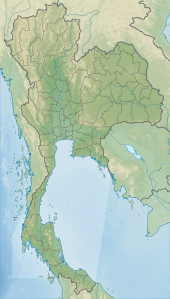Khao Laem National Park
| Khao Laem National Park | |
|---|---|
 | |
Map of Thailand | |
| Location | Kanchanaburi Province, Thailand |
| Nearest city | Sangkhlaburi |
| Coordinates | 15°01′20″N 98°35′50″E / 15.02222°N 98.59722°E |
| Area | 1,497 km2 (578 sq mi) |
| Established | 5 December 1987 [1] |
| Visitors | 66,192 (in 2019) |
| Governing body | Department of National Parks, Wildlife and Plant Conservation |
Khao Laem National Park is a park of about 1,500 square kilometers in western Thailand, located in the northern area of the Tenasserim Hills, Kanchanaburi Province. It is a part of the Western Forest Complex, a system of protected wilderness in the Dawna-Tenasserim Hills area of western Thailand.
The park surrounds the Khao Laem Reservoir in Kanchanaburi province about 340 km northwest of Bangkok. It is cut through by Road 323. The vegetation consists of mixed deciduous, hill evergreen and dry evergreen forest. It is adjacent to the Thungyai Naresuan Wildlife Sanctuary, which is situated to the northeast of Khao Laem National Park. Large animals of the area include tigers, elephants, gaurs, sambar deer, barking deer and wild boars.[2]
The park hosted the second season of New Zealand version of Survivor entitled Survivor NZ: Thailand.[3]
Geography[edit]
The area of the park is 935,584 rai ~ 1,497 square kilometres (578 sq mi)[4] with steeply limestone mountain run on north-south axis. It is located next to the Vajiralongkorn Reservoir.[5]
Climate[edit]
The area is in tropical climate which influenced by southern wind and Andaman sea wind and divided into three seasons as follows.[5]
- The rainy season (June–October), heavy raining
- The cold season (November–January), the coldest temperature recorded was 10˚C
- The hot season (February–May), the hottest temperature record was 37-38˚C in April
Flora and fauna[edit]
The park consists of mixed deciduous, hill evergreen and dry evergreen forest, which are the wildlife habitats of animals such as bears, tigers, elephants, sambar deers, barking deers, wild boars and birds.[5]
See also[edit]
References[edit]
- ^ "National Park of Thailand, Online Reservation National Park of Thailand, Forest Park of Thailand, Thailand National Park, Thailand Forest Park, Wildlife and Plant Conservation Department, Royal Forest Department". www.dnp.go.th. Archived from the original on 26 March 2009. Retrieved 12 January 2022.
- ^ Elliot, Stephan; Cubitt, Gerald (2001). THE NATIONAL PARKS and other Wild Places of THAILAND. New Holland Publishers (UK) Ltd. pp. 42–44. ISBN 9781859748862.
- ^ Fenwick, George (22 April 2018). "Thailand: braving the roads to Sangkhlaburi, ahead of Survivor New Zealand series two". The New Zealand Herald. Retrieved 7 January 2020.
- ^ "ข้อมูลพื้นที่อุทยานแห่งชาติ ที่ประกาศในราชกิจจานุบกษา 133 แห่ง" [National Park Area Information published in the 133 Government Gazettes]. Department of National Parks, Wildlife and Plant Conservation (in Thai). December 2020. Retrieved 1 November 2022, no 67
{{cite web}}: CS1 maint: postscript (link) - ^ a b c "National Park of Thailand, Online Reservation National Park of Thailand, Forest Park of Thailand, Thailand National Park, Thailand Forest Park, Wildlife and Plant Conservation Department, Royal Forest Department". Archived from the original on 2009-03-26.

